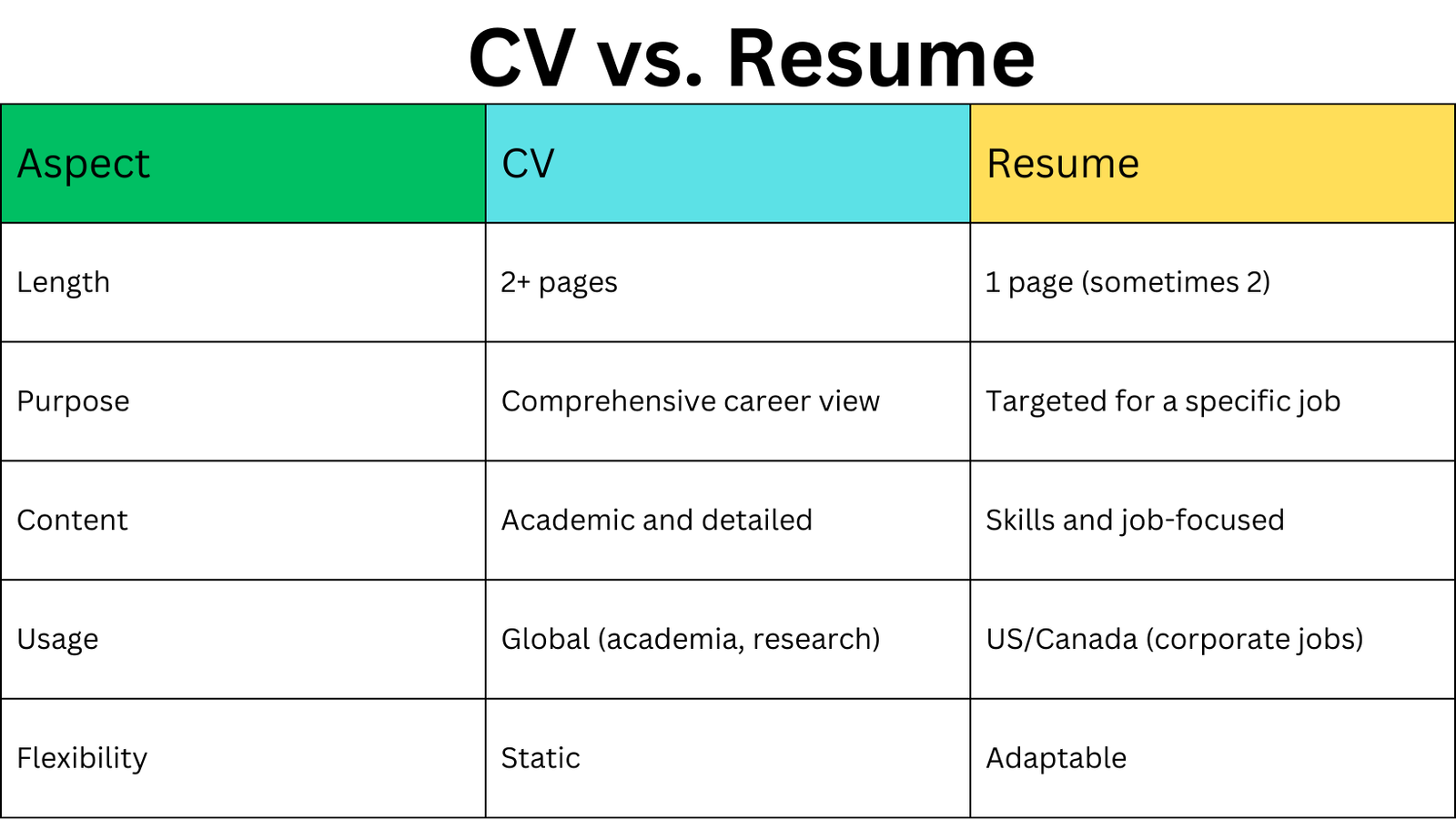
CV vs Resume: What’s the Difference and When to Use Each?
In the job application process, two documents often come into play: the CV (Curriculum Vitae) and the resume. While both serve as tools to showcase your skills, experience, and qualifications, they are not interchangeable. Understanding the (CV vs Resume) key differences and knowing when to use each can significantly enhance your job-seeking strategy.
What is a CV?
A CV, short for Curriculum Vitae, is a comprehensive document that provides a detailed overview of your academic and professional history. It is commonly used in academic, research, and medical fields or when applying for positions abroad, especially in Europe, Asia, or Africa.
Key Features of a CV:
- Length: Typically two or more pages.
- Content: Includes details about education, work experience, research, publications, awards, certifications, languages, and even personal interests.
- Purpose: Focuses on your full career trajectory and achievements.
- Format: Chronological and static, meaning it doesn’t change significantly based on the job application.
What is a Resume?
A resume is a concise document tailored to a specific job application. It highlights your most relevant skills and experiences, making it widely used in countries like the United States and Canada.
Key Features of a Resume:
- Length: Typically one page, though sometimes two pages for candidates with extensive experience.
- Content: Focuses on work experience, skills, and achievements directly relevant to the job.
- Purpose: Highlights qualifications to match the specific requirements of a job posting.
- Format: Highly customizable, allowing candidates to adapt the content for different roles.
Key Differences Between a CV and a Resume
| Aspect | CV | Resume |
|---|---|---|
| Length | 2+ pages | 1 page (sometimes 2) |
| Purpose | Comprehensive career view | Targeted for a specific job |
| Content | Academic and detailed | Skills and job-focused |
| Usage | Global (academia, research) | US/Canada (corporate jobs) |
| Flexibility | Static | Adaptable |
When to Use a CV vs a Resume
- Use a CV When:
- Applying for academic, research, or medical positions.
- Seeking jobs in countries where a CV is the standard.
- Showcasing a long list of achievements, such as publications or presentations.
- Use a Resume When:
- Applying for corporate, creative, or technical roles.
- Responding to job postings in the US or Canada.
- Emphasizing your fit for a specific job.
Read: ATS Resume Checker: Create an ATS-Friendly CV That Stands Out
Tips for Creating an Effective CV or Resume
- Be Clear and Concise: Avoid clutter and use bullet points for readability.
- Tailor Your Document: Even a CV can be slightly adjusted to highlight relevant information.
- Include Keywords: Use terms from the job description to pass Applicant Tracking Systems (ATS).
- Focus on Achievements: Quantify results where possible (e.g., “Increased sales by 20%”).
- Proofread: Ensure your document is free from typos and errors.
FAQs
Can I use a CV instead of a resume for a job application?
It depends on the job and location. In the US and Canada, resumes are preferred for most roles, while CVs are standard in academic and international contexts.
How often should I update my CV or resume?
You should update your CV or resume every time you gain new skills, experiences, or achievements, or before applying for a new job.
Is it acceptable to have a CV longer than two pages?
Yes, for academic or research roles, a CV can extend beyond two pages as it includes comprehensive details about your career.
Should I include personal information on my CV or resume?
In most countries, avoid including personal details like age, marital status, or photo unless specifically required by the employer or cultural norms.
What format should I use for my resume?
Use a clean, professional format with clear headings and bullet points. Customize it to the job you’re applying for to highlight relevant skills and experiences.
Final Thoughts
Whether you need a CV or a resume depends on the job you’re applying for and the cultural norms of the country or industry. By understanding the distinctions and tailoring your document accordingly, you can present yourself as a strong candidate and increase your chances of landing your desired role. Remember, your CV or resume is your first impression—make it count!